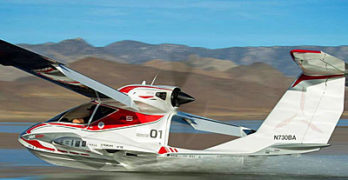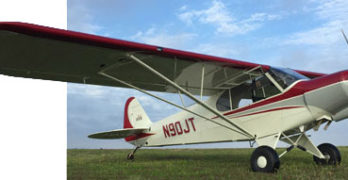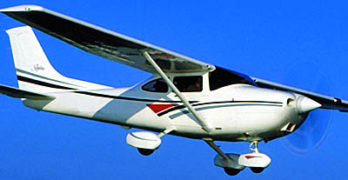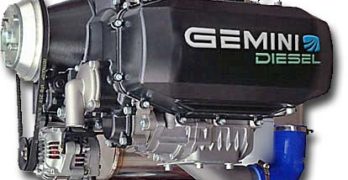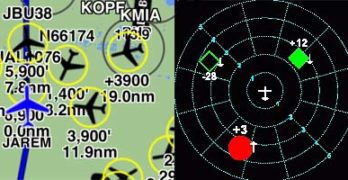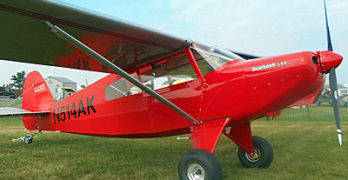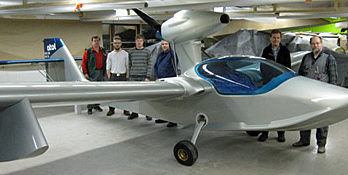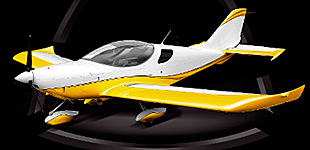I promised to tell you what was under the blue wrap disguising the powerplant on the unnamed taildragger in my earlier article. Here it comes with other opening day news from AirVenture 2015.
Icon Aircraft made their first delivery of an A5 after a tremendous media build-up, as this California company has clearly demonstrated it can do brilliantly. Not only was a huge crowd in attendance but a large flock of young people in matching tee-shirts accompanied the airplane as it was towed down the main drag — called Celebration Way — to Boeing Plaza and the runway.
The reason for the young folks was because airplane number one went to EAA’s Young Eagles, but this is especially fitting as Icon has aimed their aircraft in a different direction than any other airplane maker with which I am familiar. One pilot who flew the A5 said, “It has an automotive-like interior.
Search Results for : Texas aircraft
Not finding exactly what you expected? Try our advanced search option.
Select a manufacturer to go straight to all our content about that manufacturer.
Select an aircraft model to go straight to all our content about that model.
Super Duper Legend Cub with 180 Horses!
Whoa, big boy! When you have huge power available, you need to … well, go have fun! I’ve covered the Super Legend before (article & video), which had the multi-fuel, electronic ignition 115-horsepower Lycoming O-235 installed. Certainly that was and remains a solid powerplant but now the company has added a Titan engine that pulls like a team of stallions. Call it the Super Duper Legend Cub.
As sales of Legend Cubs and similar aircraft have shown, pilot interest in Cubalikes is strong. American Legend recently logged their 10th anniversary; they’ve been around since the LSA sector first arrived on the scene. However, they haven’t simply made the same old airplane in the same old way. Now welcome Super Legend HP.
Before Sun ‘n Fun 2015, the Sulphur Springs, Texas company announced they had added, “a host of new features for our Super Legend, adding functionality, comfort and safety to the lineage of Legend Cub aircraft.
Analyzing Statistics on Worldwide Aviation
Update Notice — The following article has been updated to reflect additional information. Please read at this link.
Thanks to a solid effort by GAMA, the General Aviation Manufacturers Association, I have data that can be used to assess the numbers of recreational aircraft around the world. That organization is significantly focused on business aircraft but did include all levels of aircraft in their country-by-country review. Whatever the actual level of accuracy — GAMA is wholly dependent on the data the organization received from various CAAs in each country — GAMA’s data is some very useful info and I am in their debt for the information discussed in this review.
In addition to GAMA having to use whatever each country reported, the methods of reporting were not consistent. For one noteworthy example, several countries listed as their smallest aircraft those weighing 5,700 kilograms (12,540 pounds), which represents far larger aircraft than your typical four-seat GA aircraft and certainly any recreational aircraft.
Is Diesel Power for LSA Superior? Yes!
“So, it looks like Rotax has finally got some worthy competition,” was a comment I received as I walked into the Sun ‘n Fun press headquarters work room. The observation came from a fellow journalist at one of the big aviation magazines. He is aware Rotax dominates the light aircraft market with an estimated 75-80% of all engine installations, even higher overseas. Who is going to give the big Austrian engine manufacturer some competition?
Superior Air Parts got started back in 1967 making components for certified engines such as Lycoming but long ago branched into their own engine line. Companies like Arion Aircraft is using an Experimental Superior XP powerplant for their new EAB speedster similar to but quite a bit faster than their LS-1 Light-Sport model. Like Arion, many already knew of the gasoline engines from this Texas company, but I knew something was up when I was approached at Sebring about a new project.
NavWorx Relieves ADS-B Out Demands for LSA
Across aviation segments of all types, noise is becoming shrill over FAA’s demand that you install Automatic Dependent Surveillance – Broadcast equipment which not only receives but sends information. The phrase is such a mouthful that everyone just says, “ADS-B Out” though that is still a mysterious abbreviation to anyone not deeply attuned to aviation instruments.
Most alphabet organizations and many aviation writers have been outspoken about the challenges faced by owners of Type Certified aircraft. A chorus of lament wails about the high equipment cost (several thousand dollars) and high installation cost coupled with what is often described as an impossible situation. According to many experts, the number of aircraft needing ADS-B Out equipment is so great that maintenance centers no longer have time to install the equipment before the deadline.
Well, that is a troubling TC-aircraft dilemma but LSA and light kit aircraft owners recently got relief from the onerous requirement.
AOPA Regional Events Wind Down … Successfully
It was interesting to visit Palm Springs for the Flying Aviation Expo‘s first-ever event at the location AOPA once said was their single best venue for the series of annual events known most recently as Summit. The Palm Springs show was larger when AOPA put it on but several reasons exist: • AOPA has 400,000 members to tap in encouraging attendance (though even at their strongest event, they drew somewhere under 20,000 visitors, I’ve been told) • the Flying Aviation Expo was a brand new event • …and, promotion for it had only begun a few months back • Flying magazine signed on as the name sponsor for the Lift Management organizers only a few weeks back. Yet I’d like to put this in perspective. Setting aside the really big shows like AirVenture and Sun ‘n Fun, aviation events appear to be doing reasonably well when they attract 5,000 people.
Affordable Bearhawk LSA Quick-Build Kit at Oshkosh
Are you lusting after a Cub lookalike but can’t afford the steep price tags these popular flying machines carry? How about something much more affordable? A taildragger called Bearhawk has picked up accolades from AirVenture judges and owners appear very loyal. Sometimes those of us close to factory built Light-Sport Aircraft tend to forget about the homebuilt community. However, more pilots exercising the privileges of Sport Pilot are flying kit-built airplanes than ready-to-fly models, a trend that is likely to continue because a kit represents a lower cost option and one where the owner can more easily do all repair work. Let me clarify, though. Bearhawk is Sport Pilot eligible (using a term my longtime EAA friend, Ron Wagner, coined); it is technically not a Light-Sport. Bearhawk LSA made its debut at AirVenture two years ago as a prototype constructed by its designer, Bob Barrows. Recently a customer flew the first completed kit.
First Factory-Built Van’s RV-12 Delivered
Forty years and more than 8,000 airplanes flying easily makes Van’s Aircraft the most prolific kit aircraft supplier in the history of aviation. Does anyone in flying not know about the RV-series? What everyone may not know (or remember) is that Van’s entered into a deal with Synergy Air to fully build an initial run of a dozen ready-to-fly RV-12s as they enter into the new and quite different realm of manufactured aircraft under the Light-Sport Aircraft rule. “We’re kind of taking it gradually into this new arena,” admitted company founder, Dick VanGrunsven as reported by our friends over at AVweb. Synergy Air is a well-established company providing instructional seminars, videos, and builder assistance to complete kit airplanes and is located at the Eugene, Oregon airport. Van’s noted that, “A total of twelve Signature Series airplanes have been completed or are under construction. All have been sold and are expected to be delivered to their new owners before the end of the year.”
On May 31st 2013 the first fly-away RV-12 went to customer George Longino.
LSA Seaplanes Remain Newsworthy in 2014
Someone remarked to me recently that LSA seaplanes seem to be the topic of the week or month (or however often you check in to see). Indeed, as we approach the tenth anniversary of Sport Pilot / Light-Sport Aircraft, we can reflect with pride upon more than 130 models making their way to market. True, not all have proven successes in the market place but having choice is always good for customers even if they finally select from a limited number of brands to occupy their hangar. Therefore, thanks to all those entrepreneurial designers that brought new airplanes to the sky. Now, in the closing months of LSA’s first decade, a new focus appears turned to amphibious Light-Sport machines, with more than 20 vying for our attention. As always some are doing a better job of capturing mindshare than others. In this article I’ll talk about two from nearly opposite ends of the new spectrum.
New Owner for SportCruiser in America
(Article udated) One of the most recognized aircraft in the LSA space is the SportCruiser, which ranks high on our LSA Market Share ranking (2012 figures). Solid in the #4 spot, they are likely to move up with another decent year in 2013, thanks to what some might call the “halo effect” of having had the Piper name on the airplane (photo) for a year, and now, a new owner. Don Ayers retired and handed the reins to his partner and new company president, Patrick Arnzen. Some thought that Piper’s quick in and out might be a negative, but that would be incorrect. Ayers once told me that his operation was the key company before Piper, during Piper, and after Piper so not much really changed other than temporarily wearing the Vero Beach company’s colors and gaining from their promotion.
In a recent conversation, Patrick explained the various activities that keep them busy including a bustling flight school operation in Addison, Texas (KADS).
- « Previous Page
- 1
- …
- 7
- 8
- 9
- 10
- 11
- …
- 16
- Next Page »


